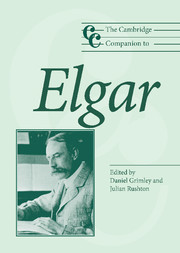Book contents
- Frontmatter
- 1 Introduction
- 2 Elgar and his British contemporaries
- 3 Elgar and his publishers
- 4 Magic by mosaic: some aspects of Elgar's compositional methods
- 5 Elgar's musical language: the shorter instrumental works
- 6 The early choral works
- 7 Elgar's later oratorios: Roman Catholicism, decadence and the Wagnerian dialectic of shame and grace
- 8 Roman Catholicism and being musically English: Elgar's church and organ music
- 9 ‘A smiling with a sigh’: the chamber music and works for strings
- 10 In search of the symphony: orchestral music to 1908
- 11 The later orchestral music (1910–34)
- 12 Elgar's unwumbling: the theatre music
- 13 Elgar and recording
- 14 Broadcasting's ally: Elgar and the BBC
- 15 Elgar in German criticism
- 16 Functional music: imperialism, the Great War, and Elgar as popular composer
- Notes
- Select bibliography
- Index
14 - Broadcasting's ally: Elgar and the BBC
Published online by Cambridge University Press: 28 September 2011
- Frontmatter
- 1 Introduction
- 2 Elgar and his British contemporaries
- 3 Elgar and his publishers
- 4 Magic by mosaic: some aspects of Elgar's compositional methods
- 5 Elgar's musical language: the shorter instrumental works
- 6 The early choral works
- 7 Elgar's later oratorios: Roman Catholicism, decadence and the Wagnerian dialectic of shame and grace
- 8 Roman Catholicism and being musically English: Elgar's church and organ music
- 9 ‘A smiling with a sigh’: the chamber music and works for strings
- 10 In search of the symphony: orchestral music to 1908
- 11 The later orchestral music (1910–34)
- 12 Elgar's unwumbling: the theatre music
- 13 Elgar and recording
- 14 Broadcasting's ally: Elgar and the BBC
- 15 Elgar in German criticism
- 16 Functional music: imperialism, the Great War, and Elgar as popular composer
- Notes
- Select bibliography
- Index
Summary
The composer has an ally in Broadcasting. Radio needs all the music it can get. If the composer can write the kind that is wanted he need not wait for a performance. Music with attractive melodies, used and harmonised with distinction of thought and fancy, is nowadays hard to find . . . Generally speaking, when a man gets home tired and ‘fed up’, he wants to be cheered by a good, lilting tune and harmony that is distinctive without being so ‘modernish’ as to disturb the increasing tranquillity of his mental state.
Thus the first BBC Handbook characterised the relationship between ‘broadcasting and the composer’ in 1928 – the sixth year of the BBC's existence – burbling on to specify that music by ‘thoroughly “English” composers is always welcomed’. The challenge for the young BBC was to discover the right music with which to define its image, with which to broadcast, quite literally, its musical identity. And as part of that, the BBC sought a specific ally, a sort of composer-mentor who could adorn and distinguish the music programmes: a ‘thoroughly English’ composer with the right demeanour and a broadly recognised reputation, who wrote music with ‘a good, lilting tune’ and just the right kind of appeal – ‘distinctive without being modernish’. That was the challenge indeed.
The fledgling British Broadcasting Company was hugely ambitious, using its ever-increasing powers and financial base to negotiate ways to make a name and establish a reputation of national and international importance and influence. When founded in 1922 and placed in the hands of John Reith, it was a tiny organisation bounded by the current state of technology, with few employees, a small audience base consisting of amateur radio enthusiasts, no identity, and no direct remit with respect to output. But there was huge potential for this new mass-market medium – and, interestingly from a musical point of view, there were no expectations, conventions or traditions about how music on air might be shaped or what it might consist of.
- Type
- Chapter
- Information
- The Cambridge Companion to Elgar , pp. 195 - 203Publisher: Cambridge University PressPrint publication year: 2005



